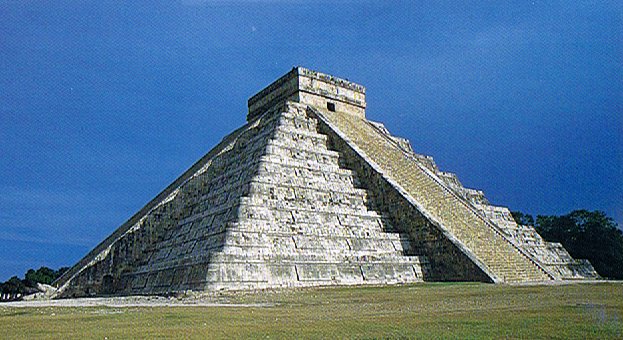The great triplet of pyramids on the
Giza plateau were
built to the
west of the Nile and they
therefore represented the side of death
(the stars were born at the horizon
in the east).
Our map below has to be
turned around in order to perceive
the pyramid of Menkaure down in the
southwest instead of up in the
northeast. Thus his life span had to
be short.
Although Alnitak (ζ) was about equal
in brightness to the central star
Alnilam (ε) and brighter than δ
(Mintaka):
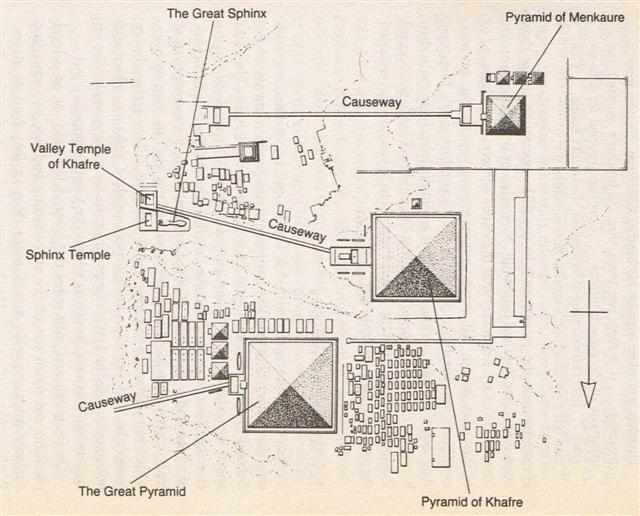
 |
 |
 |
 |
 |
|
Ga1-17 |
Ga1-18 |
Ga1-19 |
Ga1-20 |
Ga1-21 |
|
ψ Orionis (81.1),
NIHAL (Thirst-slaking Camels)
= β Leporis (81.7) |
TAU-TORU |
ο Aurigae (85.8), γ Leporis (85.9)
YANG MUN
(α Lupi)
|
|
KHUFU |
KHAFRE |
MENKAURE |
|
MINTAKA (Belt)
= δ Orionis, υ Orionis (82.4), χ
Aurigae (82.5), ε Columbae (82.6) |
Al Hak'ah-3 /
Mrigashīrsha-5 /
Turtle-20 (Monkey) /
Mas-tab-ba-tur-tur (Little
Twins)
ARNEB (Hare)
= α Leporis,
Crab Nebula = M1 Tauri (83.0, φ¹
Orionis (83.1),
HEKA (White
Spot)
= λ Orionis, Orion Nebula = M42
(83.2), φ² Orionis (83.6),
ALNILAM (String of Pearls)
= ε Orionis (83.7) |
Three Stars-21
(Gibbon) /
Shur-narkabti-sha-shūtū-6 (Star
in the Bull towards the south) /
ANA-IVA-9 (Pillar of exit)
HEAVENLY GATE
= ζ Tauri, ν Columbae (84.0), ω
Orionis (84.2),
ALNITAK (Girdle)
= ζ Orionis,
PHAKT (Phaet) = α Columbae
(84.7) |
|
June 10 |
11 |
12 |
13 (*84) |
14 (165) |
|
°June 6 (157) |
7 |
8 |
9 (*80) |
10 |
|
LESATH (Sting)
= ν Scorpii, δ Arae (264.7),
CHOO = α Arae
(264.9) |
Al
Shaula-17
ALWAID
(Mother Camels) = β Draconis,
MAASYM (Wrist)
= λ Herculis (265.1),
SHAULA (Sting)
= λ Scorpii (265.3), KUMA = ν
Draconis (265.6), σ Arae (265.9)
HAMAL (α
Arietis)
|
RAS ALHAGUE
= α Ophiuchi (266.1),
SARGAS
= θ Scorpii (266.3), μ Ophiuchi, π
Arae (266.5),
NAN HAE (Southern Sea) = ξ
Serpentis (266.6), ι Herculis
(266.7) |
λ Arae
(267.1),
GIRTAB (Seizer) = κ Scorpii,
ο Serpentis (267.6),
AL DHĪLI (The
Wolf) = ω Draconis (266.7),
DSIBAN
(Wolf Pair)
= ψ Draconis (267.9) |
KELB ALRAI
(Dog of the Shepherd) = β
Ophiuchi, μ Arae (268.1),
KEW HO (Nine
Rivers) = μ Herculis (268.6),
η Pavonis (268.7),
APOLLYON
= ι Scorpii (268.9) |
|
December 7 (*200) |
11 |
12 |
13 |
14 (348 = 165 + 183) |
... An oracle reached him from the
town of Buto, which said 'six
years only shalt thou live upon this
earth, and in the seventh thou shalt
end thy days' ...
There was not much time to build his
pyramid and therefore it became like
a dwarf compared to the great twin
pyramids of his father respectively
of his uncle:
... Here I have to
insert comments on
the word Ανακες,
because I cannot
avoid thinking of
Anakena, where
on Easter Island the
new Sun king is born
(according to
Manuscript E).
Anakeion is very
close in sound (and
possibly also
meaning) to
Anakena.
Wikipedia:
'Anax
... is an ancient
Greek word for
'(tribal) king,
lord, (military)
leader'. It is one
of the two Greek
titles traditionally
translated as
'king', the other
being
basileus.
Anax is the more
archaic term of the
two, inherited from
the Mycenaean
period, and is
notably used in
Homeric Greek, e.g.
of Agamemnon. The
feminine form is
ánassa, 'queen'
(from wánakt-ja)
...
...
The meaning of
basileus
as 'king' in
Classical Greece is
due to a shift in
terminology during
the Greek Dark Ages.
In Mycenaean times,
a
gwasileus
appears to be a
lower-ranking
official (in one
instance a chief of
a professional
guild), while in
Homer,
Anax is
already an archaic
title, most suited
to legendary heroes
and gods rather than
for contemporary
kings.
The
Greek title has been
compared to Sanskrit
...
vanij, a
word for 'merchant',
but in the Rigveda
once used as a title
of Indra. The word
could then be from
PIE *wen-ag'-,
roughly 'bringer of
spoils' (compare the
etymology of lord,
'giver of bread').

Archaic inscription
(...)i
wanakti,
'to the king', on
[a}ceramic fragment,
here shown upside
down; a warrior
bearing a spear and
mounted on a horse
is also depicted.'
The
'giver of bread'
(Lord) should
indicate the king
who enters at the
beginning of summer
(through the
Π door) and the
'bringer of spoils'
(Anax) the
other king who
enters at the
beginning of winter
(through the
underground Η door).
The ceramic fragment
depicts the Lord
King upside down -
he has turned around
from a 'cap'
position to a 'cup',
he has 'toppled' ...
|
In line Ga1 we will find the Belt stars of
Orion (Tau-toru, 'Three
Stones'), with Menkaure (Alnitak)
rising heliacally precisely at the
same time as the Pillar of Exit (Ana-iva,
α Columbae).
A girdle (Alnitak) is for women and a belt
for men (Mintaka).
...
The Sun spends part of the year with
the Winter Maid in the south, afar
out on the ocean.
The word south in the first sentence
should read north in order to make
the statement consistent with the
actual situation in the latitude of
New Zealand. The myth had apparently
been brought intact from an ancient
habitat in the northern hemisphere.
In the month of June occurs the
changing of the Sun and he slowly
returns to his other wife, to the
Summer Maid who dwells on land and
whose other name is Aroaro-a-manu.
This period we call summer. And so
acts the Sun in all the years. The
child of the Summer Maid was
Hikohiko. The old folk have told
me [Hamiora Pio, a learned
Maori] that at the time of the
winter solstice the wise men of yore
would say 'The Sun is returning to
land to dwell with the Summer Maid
...
... As the earth makes its annual
revolution of the Sun the observer
sees new constellations rising in
the east after sundown from week to
week, while others disappear in the
west and are lost in the rays of the
Sun. In the northern hemisphere we
are accustomed to associate Canis
Major and Orion with winter and
Scorpius and Sagittarius with summer
because these groups of stars
dominate the evening sky in their
respective seasons.
The Polynesians, on the other hand,
made their observations in the early
morning twilight. To the Maori
Sirius in Canis Major was therefore
a star of July and a harbinger of
frost and cold weather in their
southern latitude, so that the name
Takurua became synonymous with
winter.
Antares in Scorpius was first seen
by New Zealanders before dawn in
November - December and was
considered the herald of summer
heat, the star which ripened fruit
and enervated man.
The morning star was said to rule
the month during which it rose
before sunrise ...
It is well known that the Khufu pyramid was built in order
to represent the northern hemisphere
and similarly was the pyramid of the
Winged Serpent constructed to
visualize the year in the north:
...
Behind me, towering almost 100 feet
into the air, was a perfect
ziggurat, the Temple of
Kukulkan. Its four stairways had
91 steps each. Taken together with
the top platform, which counted as a
further step, the total was 365.
This gave the number of complete
days in a solar year. In addition,
the geometric design and orientation
of the ancient structure had been
calibrated with Swiss-watch
precision to achieve an objective as
dramatic as it was esoteric: on the
spring and autumn equinoxes, regular
as clockwork, triangular patterns of
light and shadow combined to create
the illusion of a giant serpent
undulating on the northern staircase
...
And in Ga1-18 we can see how the eye
hole in front belongs in a death
skull - winter solstice was ahead.
|
...
On the
late afternoon of the
June solstice, towards
sunset, we reached
Ahu Akivi near the
centre of the western
side of Easter Island.
This is an inland site,
3 kilometers from the
coast. Like Ahu Nau
Nau at Anakena,
it has seven Moai,
but in this case none of
them have topknots and,
uniquely, all face west
towards the sea - which
is clearly visible from
the high point on which
they stand.
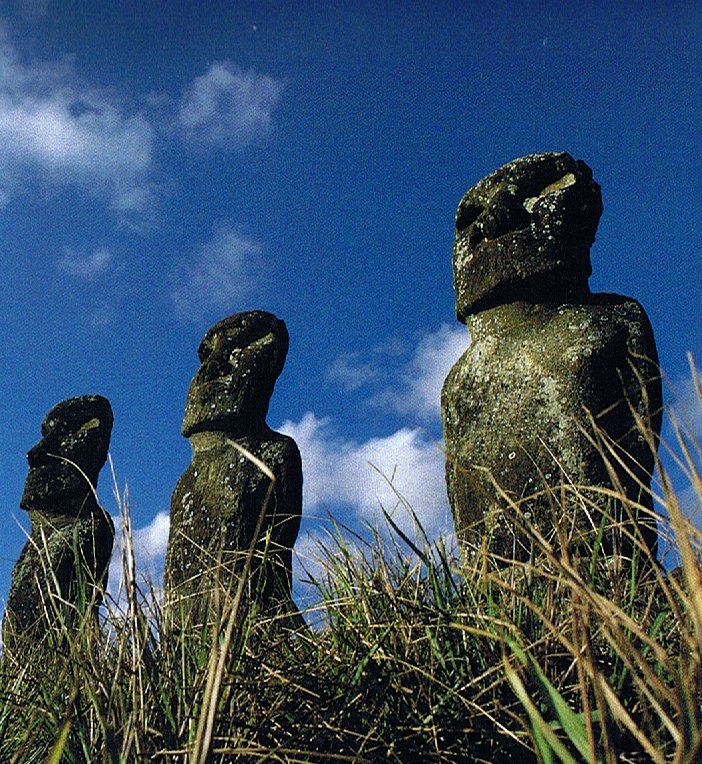
There is
a curious tradition
concerning these
grizzled, otherworldly
statues, solemn and
powerful, with their
blank, aloof eye-sockets
gazing out over the
limitless ocean. Like
most of the other
Moai of Easter
Island the local belief
is that they died, long
ago, at the time when
mana - magic -
supposedly fled from the
island never to return.
However,
in common with only a
very few of the other
Moai, it is believed
that these particular
statues still have the
power, twice a year, to
transform themselves
into aringa
ora - literally
'living faces' - a
concept startingly
similar to the ancient
Egyptian notion that
statues became 'living
images' (sheshep ankh)
after undergoing the
ceremony of the 'opening
of the mouth and the
eyes'. Statues at Angkor
were likewise considered
to be lifeless until
their eyes had been
symbolically 'opened'.
The great
stone Moai of
Easter Island were at
one time equipped with
beautiful inlaid eyes of
white coral and red
scoria. In a number of
cases - though not at
Ahu Akivi -
sufficient fragments
have been found to make
restoration possible,
showing that the figures
originally gazed up at
an angle towards the
sky. It is therefore
easy to guess why this
island was once called
Mata-Ki-Te-Rangi,
'Eyes Looking at
Heaven'.
On a
moonlit night its
hundreds of 'living'
statues scanning the
stars with glowing coral
eyes would have seemed
like mythic astronomers
peering into the cosmos.
And in the heat of the
day those same eyes
would have tracked the
path of the sun, which
the ancient Egyptians
called the 'Path of
Horus' or the 'Path of
Ra'. This was also the
'path' pursued by the
Akhu Shemsu Hor, the
'Followers of Horus',
for whom the exclamation
Ankh'Hor - 'the
god Horus Lives' - would
have been an everyday
usage.
The
principal astronomical
alignments of the great
temple of Angkor Wat
in Cambodia are towards
sunrise on the December
solstice and sunrise on
the March equinox -
respectively midwinter
and the beginning of
spring in the northern
hemisphere. The two
moments in the year when
Easter Island traditions
say that the Moai
of Ahu Akivi come
alive and are
'particularly
meaningful' are the June
solstice and the
September equinox -
respectively midwinter
and the beginning of
spring in these southern
latitudes.
Rigorous
archaeoastronomical
studies by William
Mulloy, William Liller,
Edmundo Edwards, Malcolm
Clark and others have
confirmed that the east
façade of Ahu Akivi
does have a very
definite equinoctial
orientation and, indeed,
that 'the complex was
designed to mark the
time of the equinoxes'
... |

Day 168 (at Betelgeuze,
Ana-varu) = 2 * 84 = 24 weeks. The
Julian equinox was day 84 counted from
January 1. Counting 84 days from 0h, at the
time of rongorongo, would put us at the
heliacal Pillar of Exit
(Ana-iva, α Columbae). And at the time of
Gregory XIII Ana-iva would have risen
with the Sun 4 days earlier, viz. in day 80
from 0h (and in day 160 from the beginning
of the year). The month of Father Light (Sun
as Jupiter) began in day 161, in June 10.

We can recognize the Turtle
not only by the pattern on its back but also
by its curious tail (to be contrasted by the
tail of the Lion creature). And below Aries is the figure
which comes at left in the constellation
band description. And below Taurus is the bird which comes
in its center, as number 3 of 6.
Furthermore, the dots in the Sun creature
below Leo probably identifies it as the
Jaguar - who corresponded to the Lion in the
Land of the Mayas.
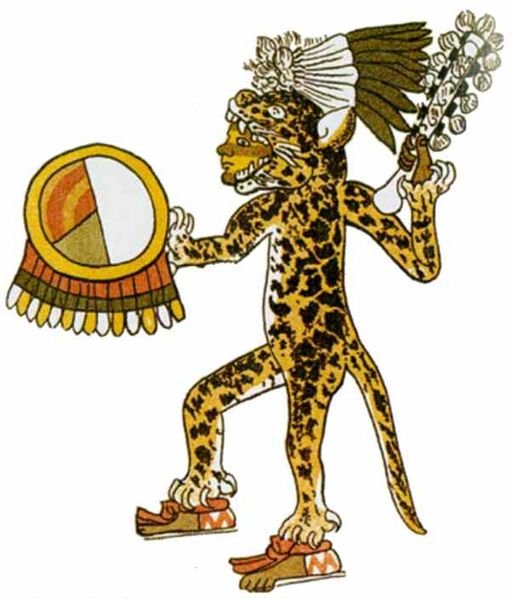
 |
 |
 |
 |
 |
|
Ga1-22 |
Ga1-23 |
Ga1-24 |
Ga1-25 |
Ga1-26 |
|
μ Columbae,
SAIPH
(Sword)
= κ Orionis (86.5), τ
Aurigae, ζ Leporis (86.6) |
υ Aurigae (87.1), ν Aurigae
(87.2), WEZN (Weight)
= β Columbae, δ
Leporis (87.7), TZE
(Son) = λ Columbae
(87.9) |
Ardra-6 /
ANA-VARU-8 (Pillar to
sit by) χ¹ Orionis, ξ Aurigae
(88.1), BETELGEUZE =
α Orionis
(88.3), ξ Columbae (88.5), σ Columbae (88.7)
ZUBEN ELGENUBI (α Librae)
|
η Leporis (89.0),
PRAJA-PĀTI (Lord of Created
Beings) = δ Aurigae,
MENKALINAN (Shoulder)
= β Aurigae,
MAHASHIM (Wrist)
= θ Aurigae, and γ Columbae (89.3), π Aurigae (89.4), η Columbae (89.7) |
μ Orionis (90.3), χ² Orionis
(90.5) |
|
June 15 |
16 |
17 (168) |
18 |
19 |
|
°June 11 |
12 |
13 |
14 |
14 |
|
MULIPHEN (Oaths) = γ Ophiuchi (269.0),
BASANISMUS = G Scorpii (269.5),
PHERKARD (Dipper) = δ Ursae Minoris (269.9) |
PTOLEMY CLUSTER = M7 Scorpii (270.5),
GRUMIUM (Lower Jaw) = ξ Draconis (270.9) |
RUKBALGETHI GENUBI (Bending Claw) = θ
Herculis (271.1), ξ Herculis (271.5), ETAMIN
(Head) = γ Draconis, ν Herculis (271.7), ν Ophiuchi (271.8) |
CAT'S EYE = NGC6543 Draconis (272.2), ζ
Serpentis (272.4), τ Ophiuchi (272.9) |
Winnowing Basket-7 (Leopard)
18h (273.4)
NASH (Point)
= γ Sagittarii (273.7), θ Arae (273.8) |
|
December 15 |
16 (350) |
17 |
18 |
19 (*273) |
|
PAINA
...
Although the Easter Islanders
still cautiously kept all their
small stone and wood carvings in
hiding, they did reveal their
own artistic talent and activity
by carrying forth colossal
paina figures in the
presence of the Spaniards
[1770]. These were skilfully
made light-weight dolls of
superhuman size, fashioned from
painted bark-cloth stuffed with
branches, grass, and reeds.
They were carried in processions
and erected at the side of old
image platforms, as if they
represented some substitute for
the giant stone men of the
Middle Period that this historic
or Late Period population was
unable to carve or erect.
Agüera (Ibid., p. 95)
gave the following account of
the paina figures, after
a description of the ancient
stone statues of which an
unspecified number were still
standing on ahu:
'They have another effigy or
idol clothed and portable which
is about four yards in length:
it is properly speaking the
figure of a Judas, stuffed with
straw or dried grass. It has
arms and legs, and the head has
coarsely figured eyes, nostrils,
and mouth: it is adorned with a
black fringe of hair made of
rushes, which hangs half-way
down the back. On certain days
they carry this idol to the
place where they gather
together, and judging by the
demonstrations some of them
made, we understood it to be the
one dedicated to enjoyment' ...
... Der Cultus bestand in
Anrufung der Götter, deren
Willen der Priester erklärte, in
Opfern an Lebensmitteln, auch an
Menschen, und in der Feier
gewisser, zu bestimmten Zeiten
wiederkehrender Feste (rakauti),
von denen das erste im Früjahr 2
Monate dauerte, das zweite im
Sommer mit der Errichtung einer
Pyramide aus Zweigen (paina)
endete, das dritte in den Winter
fiel; bei allen fanden Tänze,
Gesänge, Spiele aller Art statt
...
|
|
Paina
Human
likeness, large doll
(made in ancient
times). Vanaga. T.
To make a noise. H.
To sound, as in
breaking or tearing
anything. Churchill. |
|
Pae
1. To end, to
come to an end; ku-pae-á
taaku kai, I have no more
food; pae-atu, to leave
en masse; ku-pae-atu-á
tagata ki Hangaroa tai.
everybody has left for
Hangaroa Bay. 2. To start,
to break out (of wars, fights:
taûa); ku-pae-á te
taûa, the fight, the war,
has started. 3. Dressed, edged
stones anciently used to enclose
a permanent umu;
paepae wall of undressed
stones built as protection
against the wind; also any other
protection. Pa'e: Of a
boat, to deviate, to drift, to
stray under the effects of
currents or winds; ku-pa'e-á
te vaka i te tokerau, the
wind has made the boat deviate
from its course. Vanaga.
Paega:
1. Dressed stones forming the
foundations of the ancient
houses or of the walls of the
monumental ahus; hare
paega, house with stone
foundations; paega-ahu,
ahu wall. 2. Household, people
who live in a hare paega.
3. To lay stones on the bottom
and against the sides of a hole:
he-paega i te rua.
Vanaga.
1. Enough. 2.
Division of a subject (paiga).
Pau.: paega, a party, a
side. Ta.: pae, division,
part. 3. Threshold, sill, joist.
P Ta.: pae, sill, joist.
4. To exhaust, to finish, past;
e ko pae, impregnable;
hakapae, to exhaust, to
finish, to end, to execute, to
accomplish, to conclude, to
consummate, to consume, to
achieve, to acquit. Paea:
1. Enough, past. 2. To decay, to
waste away; paea tooa, to
deprive. Paega,
foundation. Paepae,
pavement, plank, canoe;
hakapaepae, to lay planks,
to floor. P Pau.: paepae,
a raft. Mgv.: paepae, a
pavement, to lay up stones with
regularity into a wall. Mq.:
paepae, elevated pavement on
which the house is built. Ta.:
paepae, pavement, raft.
Paero, all, totalit, to
sweep off all. Churchill. |
When the Full Moon was at
the Winnowing Basket it was the 7th day
counted for Menkaure, counted from
heliacal Alnitak:
 |
5 |
 |
|
Ga1-20 |
Ga1-26 |
|
ALNITAK (Girdle) |
NASH (Point) |
|
*84 |
*273 (18h) |
|
*84 +
183 + 6 =
*273 |
... That the Sun-gods Dionysus, Apollo
and Mithras were all also reputedly born
at the Winter solstice is well known,
and the Christian Church first fixed the
Nativity feast of Jesus Christ at the
same season, in the year A.D. 273 ...


...
Gronw Pebyr, who figures as the lord of
Penllyn - 'Lord of the Lake' - which was
also the title of Tegid Voel,
Cerridwen's husband, is really Llew's
twin and tanist
...
Gronw reigns during the second half of
the year, after Llew's sacrificial
murder; and the weary stag whom he kills
and flays outside Llew's castle stands
for Llew himself (a 'stag of seven
fights'). This constant shift in
symbolic values makes the allegory
difficult for the prose-minded reader to
follow, but to the poet who remembers
the fate of the pastoral Hercules the
sense is clear: after despatching Llew
with the dart hurled at him from Bryn
Kyvergyr, Gronw flays him, cuts him to
pieces and distributes the pieces among
his merry-men. The clue is given in the
phrase 'baiting his dogs'.
Math had similarly made a stag of his
rival Gilvaethwy, earlier in the story.
It seems likely that Llew's mediaeval
successor, Red Robin Hood, was also once
worshipped as a stag. His presence at
the Abbot's Bromley Horn Dance would be
difficult to account for otherwise, and
stag's horn moss is sometimes called
Robin Hood's Hatband. In May, the stag
puts on his red summer coat.

Llew visits the Castle of Arianrhod in a
coracle of weed and sedge. The coracle
is the same old harvest basket in which
nearly every antique Sun-god makes his
New Year voyage; and the virgin
princess, his mother, is always waiting
to greet him on the bank.

As has already been mentioned, the
Delphians worshipped Dionysus once a
year as the new-born child, Liknites,
'the Child in the Harvest Basket', which
was a shovel-shaped basket of rush and
osier used as a harvest basket, a
cradle, a manger, and a winnowing-fan
for tossing the grain up into the air
against the wind, to separate it from
the chaff.

The worship of the Divine Child was
established in Minoan Crete, its most
famous early home in Europe. In 1903, on
the site of the temple of Dictaean Zeues
- the Zeus who was yearly born in Rhea's
cave at Dicte near Cnossos, where
Pythagoras spent 'thrice nine hallowed
days' of his initiation - was found a
Greek hymn which seems to preserve the
original Minoan formula in which the
gypsum-powdered, sword-dancing Curetes,
or tutors, saluted the Child at his
birthday feast. In it he is hailed as
'the Cronian one' who comes yearly to
Dicte mounted on a sow and escorted by a
spirit-throng, and begged for peace and
plenty as a reward for their joyful
leaps.
The tradition preserved by Hyginus in
his Poetic Astronomy that the
constellation Capricorn ('He-goat') was
Zeus's foster-brother Aegipan, the Kid
of the Goat Amalthea whose horn Zeus
also placed among the stars, shows that
Zeus was born at mid-winter when the Sun
entered the house of Capricorn.
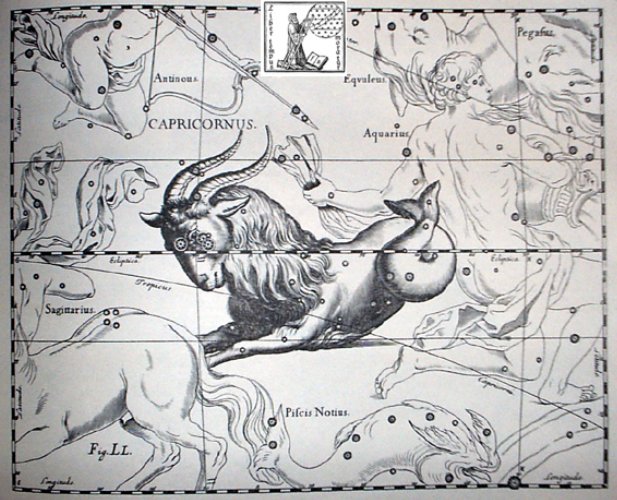
The date is confirmed by the alternative
version of the myth, that he was suckled
by a sow - evidently the one on whose
back he yearly rode into Dicte - since
in Egypt swine's flesh and milk were
permitted food only at the mid-winter
festival.
That the Sun-gods Dionysus, Apollo and
Mithras were all also reputedly born at
the Winter solstice is well known, and
the Christian Church first fixed the
Nativity feast of Jesus Christ at the
same season, in the year A.D. 273 [and
day 273 was September 30]. St.
Chrysostom, a century later, said that
the intention was that 'while the
heathen were busied with their profane
rites the Christians might perform their
holy ones without disturbance', but
justified the date as suitable for one
who was 'the Sun of Righteousness'.
Another confirmation of the date is that
Zeus was the son of Cronos, whom we have
securely identified with Fearn, or Bran,
the god of the F month in the
Beth-Luis-Nion. If one reckons back 280
days from the Winter Solstice, that is
to say ten months of the Beth-Luis-Nion
calendar, the normal period of human
gestation, one comes to the first day of
Fearn.
(Similarly, reckoning 280 days forward
from the Winter Solstice, one comes to
the first day of the G month, Gore,
sacred to Dionysus; Dionysus the vine
and ivy-god, as opposed to the Sun-god,
was son to Zeus.) Cuchulain was born as
the result of his mother's swallowing a
may-fly; but in Ireland may-flies often
appear in late March, so his birthday
was probably the same ...
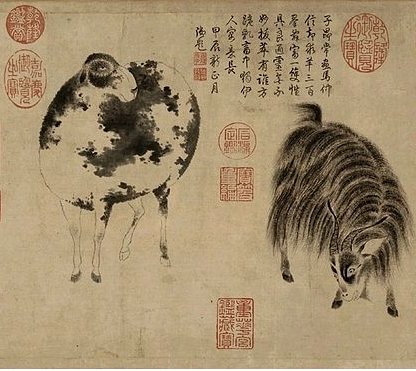
|




